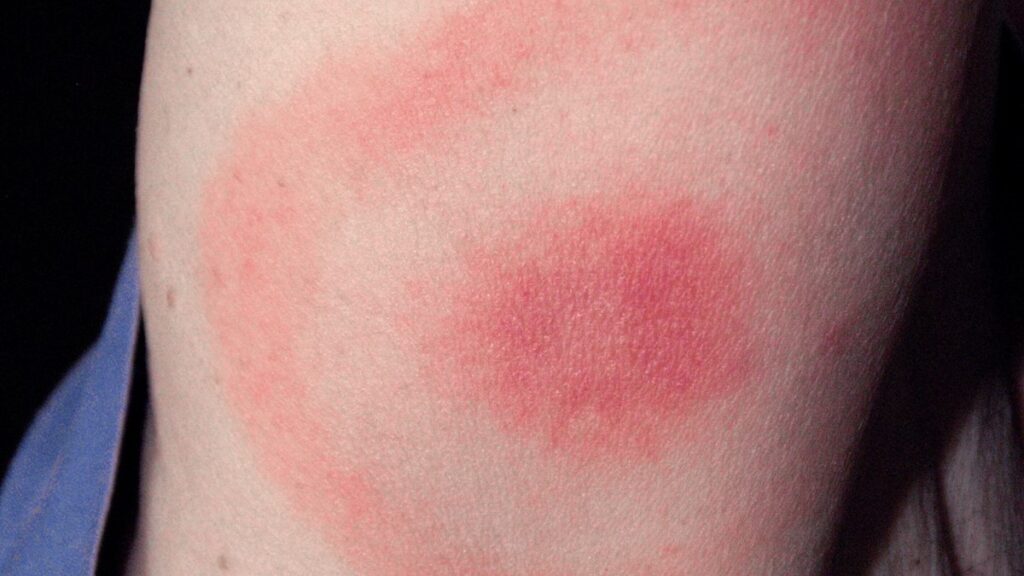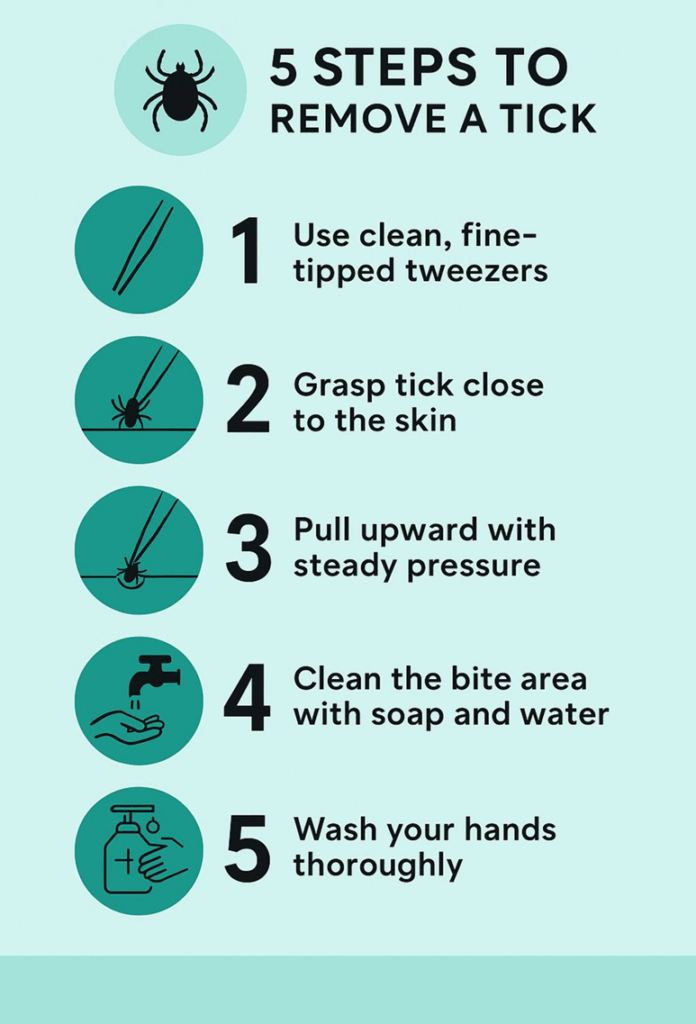
As the weather warms up and you hit the outdoors, even your backyard, you’re not alone; ticks are quietly lurking, ready to latch on and cause more than just an itchy bite. These tiny ticks carry big risks, including Lyme disease and other tick-borne illnesses. Chambersburg is a prime zone for tick activity due to its wooded areas, farmland and abundant green spaces.
Keystone Infectious Disease’s Medical Director, Dr. Raghavendra Tirupathi, and medical students studying under him, Heer Shah, Falaknaaz Saiyed and Dency Dineshbhai Mavani, explain what locals should know in today’s Take Care article.
Statistics
More than 476,000 people are diagnosed and treated for Lyme disease each year in the U.S., with most cases reported in the Northeast, Upper Midwest and parts of the Pacific Northwest.
Franklin County has seen a steady rise in Lyme disease cases each year, according to the PA Department of Health. In this article, we’ll look at common tick diseases, how they are spread, warning signs to look out for and, most importantly, how to protect yourself and your loved ones. Whether you’re a hiker, a pet owner or simply enjoy spending time in nature, this guide will help you stay informed and tick aware.
Tick-borne diseases
Tick-borne diseases are a group of illnesses which are transmitted to humans through the bite of infected ticks. These illnesses can cause a wide range of symptoms, from mild discomfort to long-term complications if not caught and treated early.
Ticks don’t fly or jump; they attach themselves to the skin of humans or animals as they pass through grassy, wooded or brush-covered areas. Once contact is made, they quickly latch on and begin feeding by embedding their mouthparts into the skin. During this feeding process, disease-causing microorganisms can enter the host’s bloodstream. This can happen quickly, in as little as 15 minutes for some illnesses. To contract Lyme disease, ticks usually need to be attached for 36–48 hours.
Depending on the species of tick and the length of attachment, a variety of serious illnesses can result, including Lyme disease, anaplasmosis, babesiosis, ehrlichiosis, Rocky Mountain spotted fever and the rare but potentially fatal Powassan virus. These diseases can cause flu-like symptoms, rashes, neurological complications or even chronic joint and heart problems if left untreated. Because tick bites are often painless and easy to miss, awareness and prevention are essential, especially in high-risk areas like Pennsylvania.
Tick-borne disease symptoms often appear three to 30 days after a bite and may be misdiagnosed as flu, allergies or stress. Be vigilant if you’ve been outdoors recently and are experiencing any of the following.
Early symptoms include fever, chills, headache, fatigue, muscle and joint pain and rash. Some advanced symptoms are heart palpitations, arthritis in knees or other large joints, memory issues, neuropathy (nerve damage which may include pain, tingling, numbness, muscle weakness and poor coordination) and facial palsy (weakness or paralysis of facial muscles, often on just one side).

Most common tick-borne diseases in the U.S.
Lyme Disease is the most reported tick-borne illness, but early treatment with antibiotics is usually effective. Lyme symptoms include fever, fatigue, headache and joint and muscle aches. In addition, about 70% of people diagnosed with Lyme will also develop a bullseye rash. Rocky Mountain Spotted Fever can also cause a rash, but it appears in spots instead of a bullseye pattern. It can also cause high fever, headache and nausea and can be fatal if not treated early.
Anaplasmosis is another disease that can be severe if left untreated. Symptoms include fever, chills, headache, muscle pain and confusion. Babesiosis infections can be particularly dangerous for elderly or immunocompromised individuals, and those infected usually report fatigue, fever, anemia and dark urine.
Ehrlichiosis is a less common illness, but is occasionally found in Pennsylvania. This is accompanied by fever, headache, nausea and fatigue. Tularemia is another rare, but potentially severe disease. It results in skin ulcers, swollen lymph nodes, fever and can lead to anemia.
Below are some common things people believe about tick-borne diseases that are not true.
Myth: You’ll always get a rash. Fact: Only about 70% of Lyme cases are accompanied by a rash.
Myth: Ticks are only in the woods. Fact: Ticks can be anywhere, even in your yard or garden.
Myth: You can only get sick in the summer. Fact: Ticks become less active during colder months, but don’t die off entirely. Some infections take a long time to show symptoms, so you could become sick months after being bitten.
Myth: If you’ve been bitten before, you’re immune. Fact: People can get tick-borne infections more than once.
Myth: You should use petroleum jelly or heat to remove ticks. Fact: These methods are not recommended. Read below to learn about proper tick removal.
What if you get bitten by a tick?
The first step is to not panic, calmly follow the following steps to remove the tick and then contact your doctor. Use clean, fine-tipped tweezers to grasp the tick close to the skin and pull upwards with steady pressure until the tick is removed. Clean the bite area with soap and water or alcohol/antiseptic wipes and wash your hands thoroughly.
If you spend a lot of time outdoors, you may want to keep a tick removal kit in your hiking bag. This should include fine-tipped tweezers and alcohol wipes or antiseptic. A magnifying glass may also be helpful.

Diagnosis and treatment
If you’ve been bitten by a tick or recently spent time outdoors and feel sick, tell your doctor. They will likely ask where you’ve been and what symptoms you’ve been having and then check for rashes, fever and other signs of a possible tick bite. They may order blood tests as well. Early diagnosis is key; delaying treatment can lead to more serious problems like arthritis, nerve issues or organ damage.
The most common treatment is antibiotics, usually doxycycline or amoxicillin, which will be prescribed for seven to 21 days, depending on the illness and how severe it is.
Rest, fluids and over-the-counter medications like Tylenol or ibuprofen help with fever, aches and pain. In more serious cases, like Rocky Mountain spotted fever or Powassan virus, hospital care may be needed for IV medications or to monitor complications like brain swelling or kidney problems.
Side effects of doxycycline
Doxycycline is usually safe, but like any medication, it can cause side effects. Some people may feel a bit of stomach discomfort or nausea. Taking the pill with food and a full glass of water and staying upright for at least 30 minutes afterward, usually helps. Don’t take it with milk or antacids as they reduce absorption. Another common side effect is sun sensitivity. While taking doxycycline, your skin may burn more easily in sunlight. It’s best to wear sunscreen, long sleeves and a hat when outdoors.
Some people might experience mild diarrhea or, in women, a yeast infection. These are usually manageable and go away after the antibiotic course is completed. It’s also worth noting that doxycycline is generally not given to children under 8 years old because it can cause permanent staining of their teeth. Rare but more serious side effects include allergic reactions, yellowing of the eyes or skin (a sign of liver issues) and vision changes. If you experience any of these, seek medical help right away.
Preventing tick bites
You can still enjoy the outdoors safely. Dress smart by wearing long sleeves, tuck your pants into your socks, and wear light-colored clothing to more easily spot ticks. Sticking to the center of trails to avoid brushing against grass and shrubs is also smart. Apply an insect repellent with DEET to your skin, and one with permethrin to your clothes.
After spending time outdoors, check yourself and children for ticks. Common places to find ticks include the underarms, behind knees, behind ears, around ankles and socks, in hair and around the waist. Shower within two hours, as this can help wash off any unattached ticks and reduce your risk of a bite. Also be sure to check your gear and use hot water to wash clothes after spending time outdoors.
Don’t forget to check your pets as well. Paws, tails, ears and collars are common hiding spots for ticks. Avoid letting your pets roam in tall grass or wooded areas and ask their veterinarian about tick prevention collars and whether they would recommend a Lyme vaccine.
Tips to make your yard safer include keeping grass short and clear of leaf piles, placing outdoor play equipment away from wooded areas, creating tick-free zones with gravel or mulch (at least three feet wide between lawn and woods) and planting tick-repelling herbs such as rosemary or lavender. To reduce chances of wildlife carrying ticks into your yard, consider installing deer fencing and making tick tubes (permethrin-soaked cotton, placed in cardboard tubes for mice – many tutorials can be found online).
Final word: Prevention starts at home
Living in Chambersburg means access to beautiful nature, but also a higher risk for tick bites. Whether you’re enjoying a walk along the Conococheague Creek or tending to your backyard garden, remember: Be tick smart. Check daily. Know the signs. Protect your family. With rising local cases, sharing awareness is just as important as wearing repellent. Let’s keep our community healthy and tick-free this season.
This article contains general information only and should not be used as a substitute for professional diagnosis, treatment or care by a qualified health care provider.




